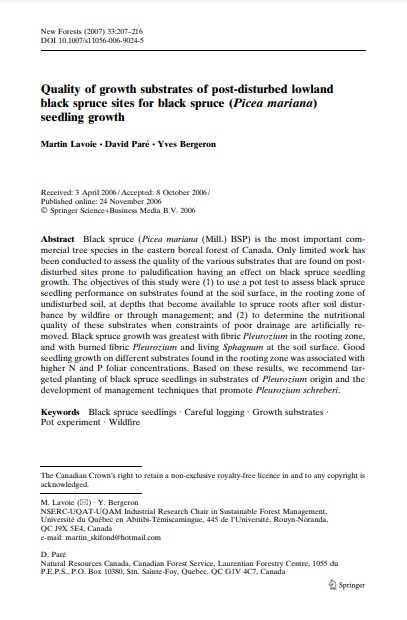Quality of growth substrates of post-disturbed lowland black spruce sites for black spruce (Picea mariana) seedling growth
Bosque Modelo:
Lake Abitibi
Temática:
Gestión forestal
Tipo de documento:
Artículo científico
Resumen
Black spruce (Picea mariana (Mill.) BSP) is the most important commercial tree species in the eastern boreal forest of Canada. Only limited work has been conducted to assess the quality of the various substrates that are found on postdisturbed sites prone to paludification having an effect on black spruce seedling growth. The objectives of this study were (1) to use a pot test to assess black spruce seedling performance on substrates found at the soil surface, in the rooting zone of undisturbed soil, at depths that become available to spruce roots after soil disturbance by wildfire or through management; and (2) to determine the nutritional quality of these substrates when constraints of poor drainage are artificially removed. Black spruce growth was greatest with fibric Pleurozium in the rooting zone, and with burned fibric Pleurozium and living Sphagnum at the soil surface. Good seedling growth on different substrates found in the rooting zone was associated with higher N and P foliar concentrations. Based on these results, we recommend targeted planting of black spruce seedlings in substrates of Pleurozium origin and the development of management techniques that promote Pleurozium schreberi.
Información Bibliográfica
Autor:
Lavoie, M, D Paré and Y Bergeron.
Revista:
New Forests
Año:
2007
N°:
2
País :
Canadá
Páginas:
207 - 216
Volumen:
33
Idioma:
Ingles
Palabras claves
Black spruce seedlings, Careful logging, Growth substrates, Pot experiment, Wildfire





